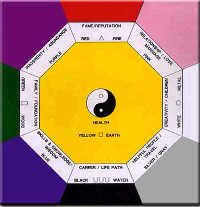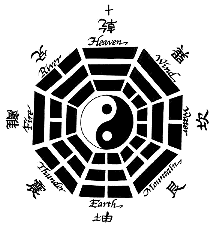| Curiosity > top |
|
|
Bagua (The Eight Diagrams) Fengshui (geomantic omen) has its core in the concept of the Bagua (Eight Diagrams) -- an eight-sided diagram derived from The Classic of Changes (I-Ching). Each side represents a different aspect of life, such as wealth, career, marriage, etc. Adjusting energy levels in each corresponding area subdues negative energy or enhances beneficial energy already present.
Bagua is used in Fengshui to find out which part of your home or office correlates to a particular situation in your life. Once you understand how to use this "map of Fengshui ," you will be able to quickly evaluate and adjust your environment accordingly to maximize on better health and productivity while improving your own quality of life. To overlay the Bagua on your home or work floor plan, stand at the threshold of the door facing inside and hold the diagram so that the blue, black, and gray guas are closest to you. Pretend you are drawing a line straight across the front of the home from the door: That would be the line at the bottom of this color chart. Sometimes it is a bit more challenging to overlay the Bagua onto a space that is oddly shaped. The Bagua is always aligned with the wall containing the front door or main entrance to any living/working space, so it can be applied to the entire house or building or to a specific room. You can also apply the Bagua to the main entry point of any exterior space, such as an entire property, a backyard or a small garden.
The picture is a composite of the Ultimate and the Eight Diagrams, and can still be found in some Chinese temples. The picture of the Ultimate consists of a black and a white fish -- also called the yin and yang fish. The picture of the Eight Diagrams is an octagon formed from eight combinations of three whole or broken lines.
According to legend, the picture was created by Fuxi, an ancient Chinese sage. It is written in the ancient book Zhou Yi (The Zhou Book of Changes): "Changes originate in the Ultimate; from the Ultimate issue the two spheres. From the two spheres issue the four elements, and from the four elements the eight diagrams". That was the basic theory of the Ultimate, giving rise to the eight diagrams. By the Ultimate, the ancient meant the origin of all things and creatures. The philosopher Zhu Xi (1130-1200) of the Southern Song Dynasty said, "The Ultimate is the way of all things in heaven and earth". The two spheres refer to heaven and earth, or yin (feminine, negative) and yang (masculine, positive). The four elements are metal, wood, water and fire, which are omnipresent. The eight diagrams symbolize the eight natural phenomena: sky, earth, thunder, wind, water, fire, mountain and lake. So, the picture represented the ancient Chinese early knowledge of the universe, which contained a simple dialectical materialist point of view. What's more interesting is the picture of the Eight Diagrams, which is formed of yao (lines), namely, the yangyao (male line, whole line written as __) and the yinyao (female line, a broken line written as - -.) The two forms are opposites and they form the eight combinations. By taking two of the lines or doubling them, 64 combinations can be made. It has been suggested that the German mathematician Wilhelm von Leibuiz (1646-1716) was inspired by the Chinese Eight Diagrams to create the binary system. If this was true, then the Chinese picture of the Ultimate and the Eight Diagrams made some historic contribution to modern computer science. In the early 1930s the Chinese scholar Liu Zihua, then 27 years of age, who was in France on a work-study program, used the Eight Diagrams (without recourse to Newton's theory of gravity), to forecast the existence of the 10th planet of the solar system. He wrote a thesis entitled "The Eight Diagrams Theory of the Universe and Modern Astronomy", which won him the French national doctorate in 1938 and shook up the world of astronomy. The Chinese picture of the Ultimate and the Eight Diagrams is still being studied by some Western scholars as a source of ancient science. It is certainly an important heritage of Chinese science and culture, though, at times, it was used for divination and other superstitious activities.
Bagua Zhang is a form of traditional Chinese internal martial arts with extraordinarily unique characteristics that make it a valuable art in the world of martial arts. It originated 160 years ago and reached its peak in the Qing Dynasty (1644-1911). Bagua conditions the body, mind and spirit with an emphasis on alternating fast and slow movements. Master Dong Haichuan was its founder and main propagator. Bagua Zhang is also a form of energy cultivation that manifests itself from the wuji state of primordial consciousness. From the primordial consciousness the taiji wheel turns, generating the realms of form with eight characteristics called trigrams. There are four cardinal and intermediate patterns of qi flow and each pattern has a direction, age, color, symbol, mantra, mudra, channel, point, form, add infintum ... and palm changes. Bagua Zhang is practiced by walking in a continual circular motion, gathering all of the energies of the eight directions; the eight palm changes create circles within the circles like the planets of the solar system rotating and revolving at the same time. Once practitioners can perform all of the eight palm changes their channels become open and they can connect with the energies of the eight directions and develop their own unique style based on their own set of circumstances and interactions with the variable energies of others who enter the Bagua sphere. Bagua Zhang is one of the three major internal styles of Chinese
martial arts. It is more vigorous and physically demanding than its sister arts
Taiji Quan and Qigong . The forms and postures incorporate
many low-squatting stances and specialize in twisting and turning the waist,
inguinal folds, legs and arms. |
||
 |

 The Picture of the Ultimate and the Eight Diagrams
The Picture of the Ultimate and the Eight Diagrams

 Bagua Zhang
Bagua Zhang